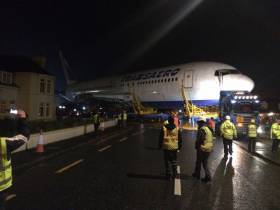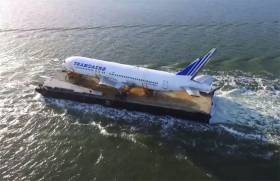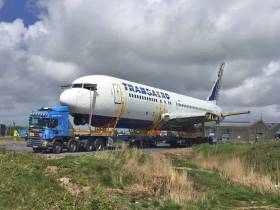Displaying items by tag: Enniscrone
#PlaneSailing - The Boeing 767 that wowed Ireland as it sailed by barge from the Shannon Estuary to a Sligo coastal town arrived at its new home, according to RTÉ News.
Preparations were being made last night (Saturday 7 May) to move the aircraft fuselage from its barge to the nearby site of Enniscrone entrepreneur David McGowan's ambitious Quirky Nights Glamping Village – where it will be converted into unique accommodation alongside converted buses, boats and black cabs.
As previously reported on Afloat.ie, the aircraft set sail from Shannon on Thursday on the barge after being lifted from the airport grounds earlier in the week using a specially commissioned cradle.
Today FM's Anton Savage Show, which has regaled listeners with McGowan's 'plane sailing' adventures over recent weeks, even broadcast from Enniscrone hours before the Boeing's arrival to mark the event.
Downtown Enniscrone of an average Saturday night.#PlaneSailing pic.twitter.com/HXbYjF3kSC
— TheAntonSavageShow (@AntonSavageShow) May 8, 2016
#PlaneSailing - Video has emerged of the Boeing 767 being sailed by barge from the Shannon Estuary up the coast to Enniscrone for its new life as part of a 'glamping' site in the Co Sligo seaside town.
Local funeral director and entrepreneur David McGowan has kept listeners to Today FM's Anton Savage Show updated on his plans to make the decommissioned plane – nicknamed 'The Big Yoke' – the centrepiece of his Quirky Nights Glamping Village concept.
As previously reported on Afloat.ie, McGowan hopes for the aircraft to arrive in Enniscrone by tomorrow (Saturday 7 May).
And what's more, The Anton Savage Show will broadcast live on location from 11am on Today FM to celebrate its arrival - follow the hashtag #PlaneSailing on Twitter for live updates.
Said Savage of the incredible story: “First we thought David was funny. Then we thought he was crazy. Now we’re sure he’s a genius.
"Any man whose business plan is a plane, train and a teapot in a field is our kind of guy. It’s an honour to be there to see the Big Yoke land.”
#PlaneSailing - A funeral director's ambitious plans for a unique 'glamping' site in Enniscrone will move a step closer to fruition later this week as he prepares to sail a passenger jet by barge up the coast from Shannon.
That's right, a passenger jet – a Boeing 767 to be precise, which David McGowan picked up for a song from a liquidating Russian airline, as the Irish Examiner reports.
McGowan is the entrepreneur behind the planned 'Quirky Nights Glamping Village' in his Co Sligo seaside town, where the former airliner will be the centrepiece of a development that will also feature repurposed train carriages, dry-docked boats London black cabs.
All will be refitted to accommodate a new kind of camper inspired by boutique festivals like Electric Picnic, people seeking the beauty of the outdoors and the comforts of hotels with a twist.
"I’m surrounded with death every week," McGowan told Today FM's Anton Savage Show of what prompted his imaginative idea to boost his coastal community's economy. "You need something to give you a buzz. You need to out and do something unusual.”
But getting the plane from Shannon Airport to Enniscrone posed a problem, as it's simply too big to transport by traditional means.
Hence the need for a barge to sail it by sea along the Wild Atlantic Way, and a specially engineered 'cradle' to lift it onto the barge.
That didn't come cheap – more than double what McGowan paid for the aircraft itself – but it did the job, and the plane is now ready at Knockbeg Point waiting for the weather to clear before the barge sets off this Thursday, expected in Enniscrone on Saturday 7 May.
A previous version of this article incorrectly attributed Independent.ie as the source of quotes from The Anton Savage Show on Today FM.
































































